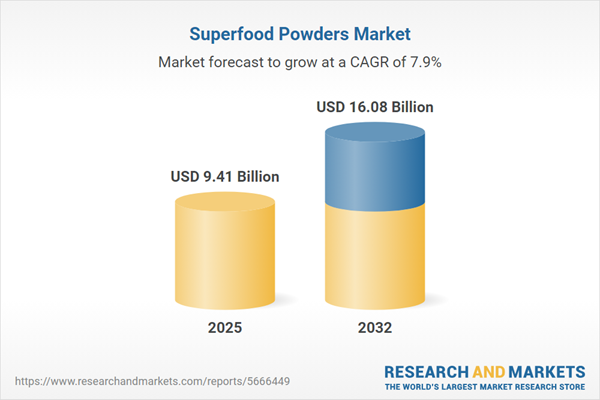Speak directly to the analyst to clarify any post sales queries you may have.
The superfood powders market is transforming as organizations align with evolving health demands, regulatory shifts, and rapid advancements in ingredient technology. Senior decision-makers must adapt strategies to secure growth, maintain agility, and drive value across market changes.
Market Snapshot: Superfood Powders Market Size and Growth Drivers
The global superfood powders market now demonstrates a compound annual growth rate of 7.92%, rising from a value of USD 8.73 billion in 2024 to USD 9.41 billion in 2025, with forecasts projecting USD 16.08 billion by 2032. Heightened demand for preventive nutrition, formulation innovation, and functional wellness products are driving this growth. Market leaders are achieving competitive advantage by integrating digital technologies, adopting sustainable practices, and rapidly responding to changing consumer and regulatory expectations. Initiatives that streamline operations and embrace traceability are elevating organizational resilience and positioning firms for expansion in a dynamic marketplace.
Superfood Powders Market: Scope & Segmentation
This comprehensive report supports executive decision-making with detailed segmentation and market relevance insights across product, distribution, application, user, regional, and innovation dimensions:
- Distribution Channels: Leverage hypermarkets, supermarkets, pharmacies, health-focused retail, specialty vitamin stores, and e-commerce platforms to broaden access and promote direct consumer engagement.
- Product Types: Expand offerings with fruit-based blends, green and vegetable powders, and protein-boosted variants to cater to a spectrum of nutritional needs and tap emerging research trends.
- Applications: Address a robust set of uses including dietary supplements, animal feed, baking, dairy, snack foods, beverage formulations, and cosmetics, driving cross-industry innovation.
- Source: Incorporate both conventional and organic superfood powders to improve transparency and ensure compliance with international standards and consumer expectations.
- End Users: Target diverse groups such as health-focused adults, athletic consumers, concerned parents, and aging populations seeking accessible nutrition solutions.
- Regional Coverage: Analyze opportunities and compliance dynamics across North America, Latin America, Europe, Middle East and Africa, and Asia-Pacific, with a focus on adapting to unique local distribution strategies and market preferences.
- Leading Companies: Assess the strategic moves of major market participants including Archer-Daniels-Midland Company, International Flavors & Fragrances Inc., Kerry Group plc, Herbalife Nutrition Ltd., Glanbia plc, The Hain Celestial Group, USANA Health Sciences, NOW Health Group, and Ingredion Incorporated.
- Technologies & Innovation: Evaluate advances in extraction techniques, preservation methods, blockchain-enabled traceability, and AI-driven nutrition personalization that are reshaping product differentiation and process efficiency.
Key Takeaways for Senior Decision-Makers
- Diversifying wellness and functional nutrition portfolios expands reach and positions organizations for growth in a competitive landscape.
- Prioritizing omnichannel strategies boosts consumer access, strengthens brand relationships, and increases the agility necessary to meet shifting demand patterns.
- Adaptive compliance measures support responsible innovation and mitigate reputational and operational risks associated with regulatory changes.
- Transparent sourcing and enhanced supply chain oversight reinforce organizational credibility and responsiveness to global compliance requirements.
- Strategic alliances and utilization of advanced analytics optimize product offerings for distinct regional or demographic market needs.
- Dynamic supplier management models limit disruptions, supporting supply continuity and resilient operations amid evolving trade or economic uncertainties.
Tariff Impact: Navigating U.S. Trade Policy Shifts
Recent changes in U.S. tariff policy have prompted a shift toward domestic sourcing strategies and stronger supplier partnerships. These adaptations streamline logistics and inventory processes while strengthening risk mitigation frameworks. Effective management of tariff-related developments fosters continued supply chain flexibility and operational stability in an unpredictable trade environment.
Methodology & Data Sources
Insights in this report are grounded in executive interviews, proprietary quantitative analysis, and scenario-based modeling, ensuring senior leaders receive reliable, data-driven perspectives tailored to the superfood powders market.
Why This Report Matters
- Guides executives with data-backed plans crafted for successful market entry, informed portfolio expansion, and optimal supply chain strategies within leading superfood powders segments.
- Delivers actionable frameworks designed to address regulatory transformation, speed sustainable adoption, and enhance operational efficiencies in key regions.
- Equips stakeholders with current market intelligence aligned with developing health trends and next-generation technology implementation.
Conclusion
By embracing strategic adaptability, ethical sourcing, and forward-thinking technology use, organizations can secure lasting value and leadership in the evolving superfood powders market.
Additional Product Information:
- Purchase of this report includes 1 year online access with quarterly updates.
- This report can be updated on request. Please contact our Customer Experience team using the Ask a Question widget on our website.
Table of Contents
3. Executive Summary
4. Market Overview
7. Cumulative Impact of Artificial Intelligence 2025
Companies Mentioned
The companies profiled in this Superfood Powders market report include:- Archer-Daniels-Midland Company
- International Flavors & Fragrances Inc.
- Kerry Group PLC
- Ingredion Incorporated
- Herbalife Nutrition Ltd.
- Glanbia PLC
- The Hain Celestial Group, Inc.
- USANA Health Sciences, Inc.
- NOW Health Group, Inc.
Table Information
| Report Attribute | Details |
|---|---|
| No. of Pages | 194 |
| Published | November 2025 |
| Forecast Period | 2025 - 2032 |
| Estimated Market Value ( USD | $ 9.41 Billion |
| Forecasted Market Value ( USD | $ 16.08 Billion |
| Compound Annual Growth Rate | 7.9% |
| Regions Covered | Global |
| No. of Companies Mentioned | 10 |









